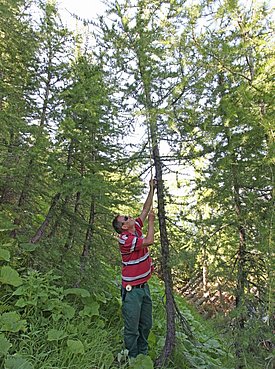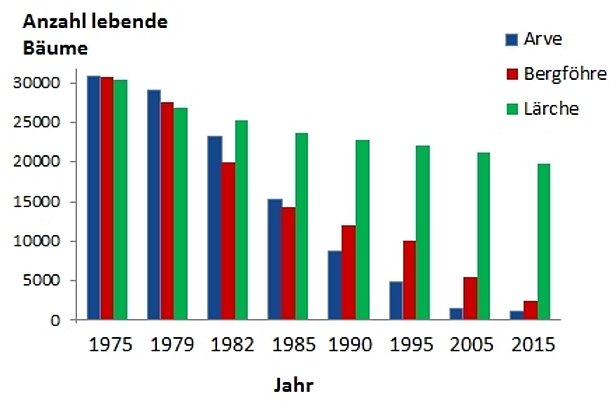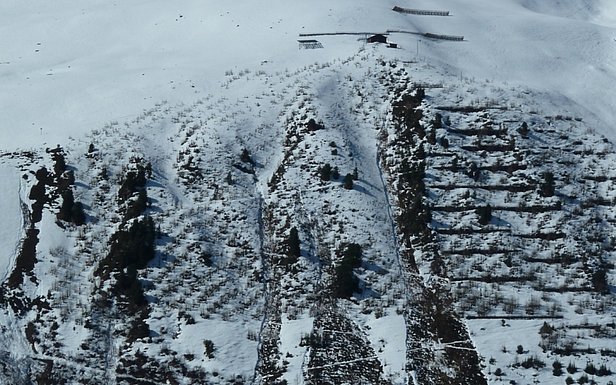
Long-term study at Stillberg ¶
What are the environmental factors that influence the growth and survival of trees at the tree line? And how do critical environmental factors change as the trees grow? The long-term research undertaken at Stillberg has enabled us to answer questions such as these.
The tree line is influenced by numerous factors. It is therefore difficult to distinguish which environmental factors are responsible for the growth and survival of trees at the tree line. The extensively reforested test site at Stillberg offers us the opportunity to do so.
Methods ¶
The five-hectare Stillberg test site is located in the Dischma Valley near Davos. Its lowermost boundary is at the approximate height of the current tree line (2,075 m above sea level), and it extends to 2,230 m above sea level. In 1975, approximately 92,000 saplings of three tree species, larch (Larix decidua), mountain pine (Pinus mugo subsp. uncinata,) and Swiss stone pine (Pinus cembra), were planted there. Researchers have recorded the growth and mortality of these plants for more than 40 years.
We evaluated these long-term data with statistical methods (classification and regression trees as well as various multivariate regression models) to determine whether and to what extent the mortality and growth of the three tree species depend on the various environmental factors including altitude, snow cover, wind speed and solar radiation.
Results ¶

The last complete inventory of the trees in 2015 found that 58% of the larches, 7% of the mountain pines and 3% of the Swiss stone pines (Fig. 2) were still alive. For all three species, mortality rates were highest during the first 15 years after planting. However, mountain pine and Swiss stone pine have exhibited a fairly high mortality rate for the past 40 years, primarily due to the pathogenic snow blight Phacidium infestans (Swiss stone pine only) and Scleroderris canker (Gremmeniella abietina). Compared to earlier reforestation phases, where small variations on site, the duration of snow cover, and elevation above sea level were crucial for tree survival and growth, these factors have become less important during the last 10 years, as tree height and tree-to-tree interactions have increased. During this time period, the larches grew even more strongly in the upper part of the reforestation area (> 2,150 m above the current tree line) than below, where there is more competition among the trees.

In 2015, the trees had an average height of 2.8 m (± 1.4 m) and have been able to substantially stabilise the snowpack during the last five years. Whereas numerous avalanches originated in the area without avalanche barriers as late as 30 years after reforestation, there has been no avalanche event since 2011 (Fig. 3). Many larches have already grown to heights of twice the maximum snow depth. Swiss stone pines and mountain pines are even smaller, but have a greater influence on the snowpack.
Conclusions ¶
- The 40-year experiment clearly demonstrates the different ways in which trees at the tree line react to environmental influences during their early growth periods and what it takes for new, functional protective forests to emerge in high-altitude avalanche control areas.
- In addition, previous recommendations for high-elevation reforestation have been substantiated after 40 years. The selection of tree species which are well-suited to small-scale sites, the diversity of tree species, and temporally staggered replanting or tending interventions are also important.
- The continuation of long-term studies is recommended. In future, the issues of competition, protective functions and remote sensing applications will become even more important.
